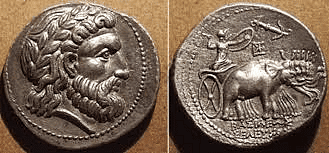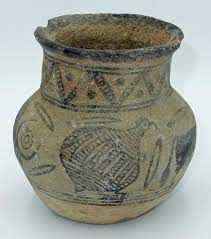Class 6 History Chapter 5 Question Answers - Kingdoms, Kings and an Early Republic
Q1: What do you mean by The word "Janapadas"?
Ans: Land where the Jana set its foot and settled down.
The etymology of the word is often explained as "Jana" meaning people or subjects, and "Pada" meaning foot or step. Therefore, "Janapadas" is interpreted to mean the "land where the Jana set its foot and settled down," reflecting the establishment of early political entities or states in ancient India.
Q2: Janapada could be a republic or a ________.
Ans: Monarchy

Q3: What do you mean by mahajanapadas?
Ans: Some janapadas gained control over large areas and became mahajanapadas.
Q4: List an important characteristic of the Ganges civilisation of Northern India.
Ans: Painted greyware is frequently decorated with simple designs in black or red paint. These were used on special occasions to serve special food.
Q5: What was the use of the Painted grey ware?
Ans : These were used on special occasions to serve special food.
Painted Grey Ware is a type of pottery associated with the later Vedic period in ancient India. It was not specifically used for serving special food on special occasions. Instead, it was commonly used for various purposes, including storage and cooking. The pottery gets its name from the characteristic grey color and the painted designs on its surface.
Q6: Who conquered the last of the ganas or sanghas?
Ans : Gupta rulers
Q7: What is the meaning of term Ashvamedha ?
Ans : horse sacrifice
The term "Ashvamedha" refers to the ancient Vedic ritual of horse sacrifice, a significant religious ceremony in ancient Indian traditions.
Q8: Some kings were recognised as 'rajas' due to the big sacrifices they made. True/False
Ans : True
Q9: Why did kings fortify their capital city?
Ans: For protection and to show off their wealth.
Q10: Who composed later Vedic books?
Ans: Priests

Q11: Who succeeded the throne in a hereditary monarchy?
Ans: The heir, usually a son or daughter.
Q12: Write the name of a new tool which was used to dig earth for turning the soil and planting trees.
Ans: Plough
The term you're looking for is likely "plough" or "plow." A plough is a tool used for turning the soil, preparing it for planting crops or trees. It is an essential agricultural implement for tillage.
Q13: The Shudras had to serve the other three groups from the caste hierarchy. True/False
Ans: True
In the traditional caste hierarchy in certain ancient Indian societies, the Shudras were often assigned the role of serving the other three varnas (Brahmins, Kshatriyas, and Vaishyas).
Q14: In which form of government does a king have absolute power?
Ans: Absolute monarchy.
Q15: List a work done by Kammakaras.
Ans: The work of transplantation of paddy was a back-breaking work.
Q16: Amongst the others, the later vedic literature generally included the _________.
Ans : Sama Veda
The later Vedic literature generally included various texts, and among them, the Sama Veda is one of the four Vedas. The Vedas are a collection of ancient sacred hymns and rituals that form the foundation of Hindu religious knowledge. Each Veda, including the Sama Veda, has its own significance and purpose in the Vedic tradition.
Q17: Into how many groups, the later Vedic society was divided?
Ans: Four
The Later Vedic society was often classified into four main groups known as Varnas. These are:
- Brahmins: The priestly class responsible for rituals and religious ceremonies.
- Kshatriyas: The warrior and ruler class responsible for protection and governance.
- Vaishyas: The merchant and agricultural class involved in trade and commerce.
- Shudras: The laboring class providing various services to the other three varnas.
Q18: How many mahajanapadas was there?
Ans: There were altogether 16 mahajanapadas.
The number commonly mentioned is 16 Mahajanapadas, which were major political and territorial units during the 6th to 4th centuries BCE.
Q19: The special type of pottery found at Janapadas was _____________.
Ans: Painted grey ware

Q20: Why did kings fortify their capital city?
Ans: For the protection and to show off their wealth
Q21: Soldiers of the ancient period were paid regular salaries. True/False
Ans: True
Q22: List one of the major changes that occurred in the field of agriculture.
Ans: The growing use of iron ploughshares.
The growing use of iron ploughshares in agriculture is indeed a significant change. The adoption of iron ploughs marked an advancement over earlier wooden or stone implements, as iron ploughs were more durable and effective in turning the soil, contributing to increased agricultural productivity.
Q23: What led to the increase in the production?
Ans: The introduction of iron plough led to increase in the production.
Q24: Name the group of people who were not allowed to participate in the assemblies of the ganas.
Ans : women, dasas and kammakaras
Excluded from the ganas assemblies were women, dasas (slaves), and kammakaras (manual laborers), reflecting the social structure of ancient assemblies in early Indian history.
Q25: Alexander lived in ______________.
Ans: Macedonia, in Europe
Q26: Buddha and Mahavira belonged to which group?
Ans: Kshatriyas
Buddha and Mahavira belonged to the Kshatriya group, the warrior or noble class, in ancient Indian society.
Q27: What was the name of the minister of Ajatasatru?
Ans: Vassakara
The name of Ajatasatru's minister was Vassakara.
Q28: Ajatasattu wanted to attack the __________.
Ans: Vajjis
Q29: Name a famous Buddhist book.
Ans: Digha Nikaya

Q30: What is the other name of the famous Buddhist book 'Collection of Long Discourses’?
Ans: Digha Nikaya
The Collection of Long Discourses is also known as Digha Nikaya in Buddhism.
Q31: Why did Alexander’s soldiers refuse to march further from the bank of river Beas?
Ans: They were afraid of the Indian armies.
Q32: What did the forests provide to the people of Magadha?
Ans: Wood for building houses and chariots
Q33: Bimbisara and Ajatasatru were rulers of ____________.
Ans : Magadha
Q34: In Magadha, elephants were captured and used in army. True/False
Ans: True
Q35: Avanti had its capital at _____________.
Ans: Ujjain
Q36: What was the most important source of revenue to the state?
Ans : Agriculture
Q37: What was Bhaga or a share?
Ans: The tax was fixed at 1/6th of the crop produced. This was known as bhaga or a share.
Q38: Name the great religious leader who belonged to Gana-sangha.
Ans: Lord Mahavira
Q39: Name the capital of the state of Vajji.
Ans: Vaishali
Q40: The capital of Magadha shifted from _______to _______.
Ans : Ujjain to Vaishali
|
69 videos|386 docs|80 tests
|
FAQs on Class 6 History Chapter 5 Question Answers - Kingdoms, Kings and an Early Republic
| 1. What were the main characteristics of kingdoms and kings during ancient times? |  |
| 2. How did the early republic differ from the kingdom system? |  |
| 3. What led to the transition from kingdoms to the early republic? |  |
| 4. How did the role of the king change in the early republic? |  |
| 5. What were the advantages and disadvantages of the kingdom system compared to the early republic? |  |





















